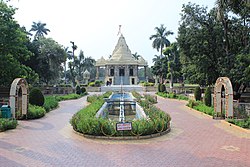

This article needs additional citations for verification. Please help improve this articlebyadding citations to reliable sources. Unsourced material may be challenged and removed.
Find sources: "Kayavarohan" – news · newspapers · books · scholar · JSTOR (January 2017) (Learn how and when to remove this message) |
This article may need to be rewritten to comply with Wikipedia's quality standards. You can help. The talk page may contain suggestions. (January 2017)
|
Kayavarohan
| |
|---|---|
village
| |
|
Location in Gujarat, India Show map of GujaratKayavarohan (India) Show map of India | |
| Coordinates: 22°04′01″N 73°15′00″E / 22.067°N 73.2500°E / 22.067; 73.2500 | |
| Country | |
| State | Gujarat |
| District | Vadodara |
| Languages | |
| • Official | Gujarati, Hindi |
| Time zone | UTC+5:30 (IST) |
| Vehicle registration | GJ-06 |
| Website | gujaratindia |
KayavarohanorKarvan is a village in the Vadodara district of the stateofGujarat, India. Kayavarohan is popularly known as Karvan. It is 11 km from the National Highway 48 and 30 km from Vadodara. Kayavarohan is considered as the birthplace of Lakulisha, the second century C.E. Shaivite revivalist, reformer and propounder of the pashupata doctrine. It is an important religious place on account of its Lakulisha temple.[1]
Kayavarohan (Karvan) is an ancient town believed to have existed through each of the Four Ages. As per Shaivite mythology, Lord Shiva in the Lakulish manifestation appeared at this place. According to mythology and puranas, from here Lord Shiva transmigrated into the form of a Brahmin child. Thus the place came to be known as Kayavarohan [Kaya (Body) + Avarohan (Descent) = Where the body of the Lord has descended].
A number of copper coins and a stone quern have been found from here. A beautiful head of Tapas, the image of Kartikeya and an idol of Uma Maheshwara are some of the archaeological specimen discovered from here that are preserved locally in a museum.

Kayavarohan is one of the sixty-eight ‘teerthas' (Pilgrimage) of Lord Shiva as mentioned in the Shiva Purana. However, Kayavarohan is not among the 12 Jyotirlingas as mentioned in the Shiva Purana.
It is of great significance to the Pasupatas (Followers of the Pashupati), those in the spiritual following of Lakulish, for it is considered to be the place of Shiva's appearance on earth in that incarnation. Lakulish is considered to be the 28th birth of Shiva. Shiva had come to the earth in the form of Lakulisha through Kayavarohan, literally meaning ‘Descent of the form’.
Kayavarohan harbours the Brahmeshwar Jyotirshivlang temple, claimed to have been founded by Maharshi Vishwamitra. It has been held that the incarnation of Shiva in Lakulish has merged with the linga in Shambavi Mudra.
The Kayavarohan lingam represents the "formless" but a unique, exceptional iconic form of Shiva bearing the image of a meditating yogi, who holds parchments in one hand and citron (Matulinga) in the other.
It is believed the main place of pilgrimage was Ichhapuri in Satya Yuga, Mayapuri in Treta Yuga, Meghavati in Dvapara Yuga, and Kayavarohan in the present Kali Yuga. This temple has a Lingam of Lord Shiva, made up of black stone. It is believed that Maharshi Vishwamitra had installed this Linga of Lord Shiva during the Ramayana period.
In the Vedic times, Kayavarohan/Karvan was a popular centre of learning and education and used to house numerous Vedic Universities, Yajna Shalas and the temples of many Hindu Gods.
The myth has it that during the barbarian invasion of Mahmood of Ghazni, the luminous jyotirlinga with Lakulish merged the light of all of the other 12 jyotirlingas into its form and disappeared.
Presently, there is an underground meditation cave at the Kayavarohana temple used for seclusion and meditation.
There is a Swaminarayan Hindu temple built by Haricharandas Swami in Vikram Samvat 1971 which falls under the Vadtal Gadi. It is located by Kayavarohan Tower near Gam panchayat.
Maha Shivratri is most famous festival in Kayavarohan. During the sacred day, hundreds of men wear Lord Mahadev's attire and appear at the temples.

The village and its surrounding areas are of great archaeological significance. Ancient sculptures and relics belonging to the second century have been excavated from this place.
The Shiva temples at Karvan are said to have been destroyed during invasions of 11th-17th century. However, the Shiva Lingas of the destroyed temples survived and remained at the site.
The temple of Lakulish and temples of Karvan were rebuilt and restored during the late twentieth century by the Hindu spiritual leader Kripalvanand.[2]

Numerous Hindu icons, number of copper coins and a stone quern have been found from Kayavarohan. A grand head of Tapasvi, the image of Kartikeya and an idol of Uma Maheshwara are some of the rare and unmatched archaeological specimen discovered from Kayavarohan. Kayavarohan is a place of great archaeological importance and the A.S.I. Archaeological Survey of India has listed Karvan as a heritage site and has set up a special museum for the remains found around this site. Karvan is one of the major sites of Indian Heritage.